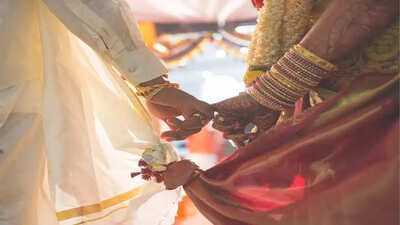
Hindu marriages are not just social ceremonies; they are a
yajna (sacrificial ritual), an offering to the divine that transcends the physical union of two individuals. They are a blend of profound spiritual truths, ancient wisdom, and eternal vows rooted in the Vedas, where every ritual is a prayer, every act is sacred, and every step is a journey toward oneness—not just with each other but with the universe itself.Let’s walk through the rituals, understand their meanings, and uncover why a Hindu marriage is considered as pure as worship.
1. Kundali Matching and the Role of the Stars
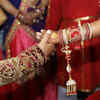
Aligns karmic paths through Vedic astrology for harmony.
The journey of a Hindu marriage often begins with
kundali (horoscope) matching. Far from being mere superstition, this practice is based on Vedic astrology, which views marriage as the merging of two karmic paths. The alignment of the stars and planets is believed to influence the harmony of the couple, ensuring their union is in sync with the cosmos. In Hindu thought, marriage is not an accident but a preordained meeting of two souls bound by
samskaras (impressions from past lives). The kundali matching ensures that their energies align, paving the way for a harmonious partnership.
2. Ganesh Puja
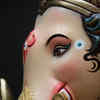
Invokes divine blessings, ensuring an auspicious start.
Before the wedding begins, the couple invokes Lord Ganesha, the remover of obstacles. This is a moment of surrender to divine will, a prayer that the union be free from hindrances. The puja signifies that the marriage is not just a human endeavor but a sacred duty undertaken with divine blessings.
This ritual sets the tone for the ceremony, reminding everyone present that the marriage is a sacred bond sanctified by the gods.
3. Kanyadaan: The Highest Act of Giving
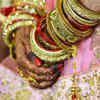
Bride's parents entrust her to the groom with blessings.
The
kanyadaan—the giving away of the bride—is one of the most sacred acts in Hindu dharma. The bride’s parents place her hands in the groom’s, symbolizing the transfer of responsibility and blessings. The father recites:
“I offer to you my daughter, a treasure of virtue. May you cherish her as you would cherish your own soul.” This ritual reflects the concept of selflessness and surrender, as the parents entrust their daughter to the groom with the hope that he will honor, protect, and cherish her as the embodiment of the goddess Lakshmi.
In the
Shastras, it is said that
kanyadaan is equivalent to offering the divine itself, underscoring the sanctity of the act.
4. The Agni: The Eternal Witness

Sacred fire witnesses vows, symbolizing divine presence.
At the heart of a Hindu wedding is the sacred fire (
agni), representing purity, light, and divine presence. The couple performs the
homa (fire offering), a ritual that connects them to the gods. The fire is not merely symbolic; it is a direct link to the divine, a witness to their vows.
The couple walks around the fire, taking the
saptapadi (seven steps), which form the cornerstone of the marriage. Each step corresponds to a vow:
To nourish each other and provide for their family.
To grow together in strength and prosperity.
To preserve virtue and remain faithful.
To share all worldly joys and sorrows.
To care for each other and their children.
To walk together in harmony and understanding.
To remain friends, companions, and spiritual partners for life.
With each step, the bond between the couple deepens, transforming their union into a sacred partnership.
5. The Mangalsutra and Sindoor
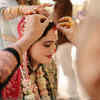
Symbols of eternal bond and divine protection.
The
mangalsutra, a sacred thread tied by the groom around the bride’s neck, symbolizes the eternal bond of marriage. It is not just a piece of jewelry; it is a prayer for the bride’s well-being and prosperity. The groom also applies
sindoor (vermilion) to the bride’s forehead, marking her as married. This act signifies his vow to protect and honor her, and it is believed to invoke divine blessings for her longevity.
6. The Sacred Bond
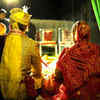
Union leads to spiritual growth and self-realization.
In Hindu philosophy, marriage is not merely a physical or emotional union; it is a spiritual partnership. The
Manusmriti describes marriage as the foundation of dharma (righteous living), where the couple supports each other in fulfilling their duties to family, society, and the divine. Together, they pursue the four
purusharthas (goals of life):
Dharma: Righteousness and duty.
Artha: Material well-being.
Kama: Love and desire.
Moksha: Spiritual liberation.
This spiritual perspective elevates marriage beyond a worldly contract, transforming it into a journey toward self-realization and union with the divine.
7. The Emotional Weight of the Rituals
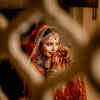
Emotional rituals evoke gratitude, responsibility, and devotion.
For those present, a Hindu wedding is not just a ceremony; it is a deeply emotional experience. The bride’s farewell (
bidaai), for instance, is often marked by tears—not just of sadness, but of overwhelming gratitude and reverence. The moment she steps into her new life, she carries the blessings of her parents, the prayers of the gods, and the hopes of everyone around her. Similarly, the groom’s vows evoke a profound sense of responsibility and devotion. As he promises to honor and protect his wife, you can feel the weight of the moment—a merging of two lives, two destinies, and two souls.
Marriage as Worship: A Timeless Truth
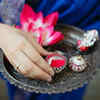
Sacred journey toward divine union of two souls.
In Hinduism, marriage is often described as
ardha-nareshwara—a union where two souls become one, like Shiva and Parvati. It is an act of surrender, where the ego dissolves, and love becomes a path to the divine. Every ritual, every vow, and every prayer in a Hindu wedding is a reminder of this ultimate truth.
As the
Atharva Veda beautifully proclaims:
“You have become mine forever.
I am yours forever.
Let us live a hundred years together,
in strength, in harmony, and in happiness.”
 Hindu marriages are not just social ceremonies; they are a
yajna (sacrificial ritual), an offering to the divine that transcends the physical union of two individuals. They are a blend of profound spiritual truths, ancient wisdom, and eternal vows rooted in the Vedas, where every ritual is a prayer, every act is sacred, and every step is a journey toward oneness—not just with each other but with the universe itself.Let’s walk through the rituals, understand their meanings, and uncover why a Hindu marriage is considered as pure as worship.
Hindu marriages are not just social ceremonies; they are a
yajna (sacrificial ritual), an offering to the divine that transcends the physical union of two individuals. They are a blend of profound spiritual truths, ancient wisdom, and eternal vows rooted in the Vedas, where every ritual is a prayer, every act is sacred, and every step is a journey toward oneness—not just with each other but with the universe itself.Let’s walk through the rituals, understand their meanings, and uncover why a Hindu marriage is considered as pure as worship.







